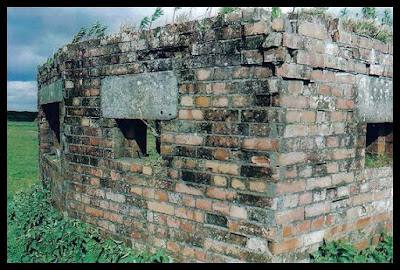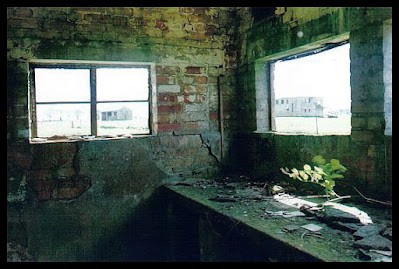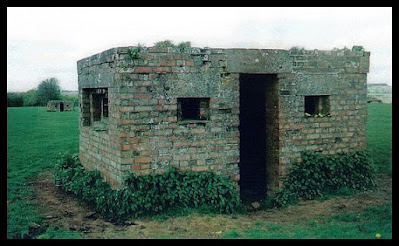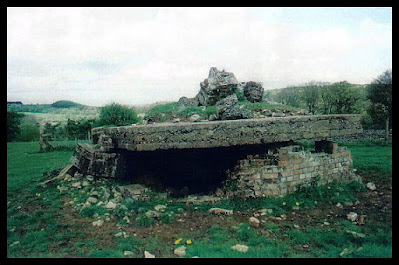RAF Culmhead is one of three WW2 airfields situated close together on the beautiful Blackdown Hills, the other two being Upottery (Smeatharpe) and Dunkeswell. The Blackdown Hills straddle the border between Devon and Somerset and Culmhead is the only one in Somerset. This is the last of visits to all three made in January and February 2009; the other ones can be seen in the previous two posts.
As I did with the other articles, I've added subtitles for the specific buildings or areas to make things easier to get through a copious amount of photos, with information & history interspersed throughout.
Originally called Church Stanton, RAF Culmhead opened as a three-runway fighter airfield on 1st August 1941, and was later renamed to avoid confusion with Church Fenton in Yorkshire. Also known as Trickey Warren because it was built on the land belonging to the farm of the same name. Some of the farm buildings were utilized for the airfield.
It began life as an emergency landing ground and dispersal airfield, and was also used as a base for the testing of barrage-balloon wire cutters. As a fighter base for Spitfires and Hurricanes, it was occupied by No 2 Polish Fighter Wing and later by Czech units. English pilots were also based there. The fighter planes protected bombers crossing the channel and also intercepted and shot down enemy aircraft overland.
Following D-Day it was used for training the first jet-engined aircraft in RAF service. This comprised two Meteors, which arrived in July 1944. There was very little activity other than that, and was subsequently closed in August 1946.
Although there aren't a huge amount of buildings remaining at Culmhead, what's left is interesting, and there are some unusual finds too. These include two control towers situated near to each other, the first being a Fighter Satellite Watch Office and the second, a Watch Office for All Commands. There is also a loopholed defence wall which is still in very good condition. And a boat!
Airfield Defences
Our 'ground crew' on this visit consisted of Ricasso, Billy and Shaun Churchill - author of the website WW2 Airfields - who kindly accompanied us to act as our guide. Parking at the centre of the airfield where there is now a business park, our first port of call was the pillbox defences around the perimeter.
Complete with metal shutters, which I hadn't seen before on other pillboxes in real life so that was a first for me.
Both of these, above and below, are Type 24 pillboxes; irregularly hexagonal with the rear wall longer than the other five, in which the entrance is placed.
And a look inside, showing the gun rest beneath the loophole embrasure.
M.T. Vehicle Shed & Yard
One of the cement door stops can be seen in the foreground of the right photo above. A vehicle pit was usually built in one of the bays inside, but due to the high water table a separate vehicle inspection ramp was built outside, seen below.
And a Motley Stalk mount amongst the rubble in the middle foreground below, which was a first for me as I hadn't seen these before. More about those later.
Clothing Store and Technical Latrine
And a random piece of roller equipment, presumably belonging to the farm, looking rather like a humungous snail. Once a farm called Trickey Warren before becoming the airfield, it then returned to farmland once again.
Parachute Store
With a chimney that's fallen inside.
Some hard standing where a building once stood, possibly a hut by the look of its shape.
Fighter Satellite Watch Office
This was the original watch office, which later became the Battery Charging Building. Inside, below.
Watch Office for All Commands
Complete with the boat. I sometimes say that I often find a boat on my Devon explores...except that this one's in Somerset!
On the watch office at Upottery only the balconies remained and none of the stairs, whereas at Dunkeswell all the stairs were still there. Here it's a bit half and half, as one of the staircases still manages to cling on, albeit without most of its treads, seen below.
Floodlight Tractor and Trailer Shed
Airfield Defences
More pillboxes, the first one collapsed or demolished with the rubble remains and hard standing left in situ.
Two more T24s.
I love this embrasure with it's 'window box' of bright dandelions.
And another collapsed one. Interestingly, after the war farmers were awarded £5 for every pillbox demolished. Not an easy thing to do because of their reinforced ceilings, although £5 was a considerable amount of money back then. Fortunately, there are quite a lot of pillboxes remaining throughout Britain, thanks to those farmers who decided not to.
I'm not sure what these remains below are. I have read that there was a much larger, square-shaped gun pit, since demolished or filled in, possibly for a bofors gun. However, even with the map it's almost impossible to say where it is/was in relation to my photos, and this one could have been a pillbox, hut or something else.
Gun Mounts and Pits
The Motley Stalk mount, which we saw earlier on, was used for light anti-aircraft guns, such as the twin Browning machine gun. Another one below.
The below ground defence with another Motley Stalk was also a first for me and such a good find. Known as a Keyhole pit, it comprises a rectangular and circular area, the latter - where the gun was positioned - enabling 360ᵒ sight.
Amongst a small copse of trees and undergrowth was another pillbox. Actually, I seem to remember there was more than one, but they were too difficult to get near or too tangled in the undergrowth to photograph.
And another further on, barely seen pillbox in the undergrowth, complete with a quite a few discarded tyres.
Flight Offices and Latrine
And another random piece of equipment. That and the 'snail' most likely belonging to the farm.
Aircraft Pens & Stanton Shelters
Stanton Shelters are positioned around the aircraft pens. Another first for me. Difficult to see with all the undergrowth, the entrance to the one above is the dark shape on the right, with two more pillboxes on the left horizon.
Sorry for the poor quality photo on the right, below, but I had to include it as it was my one and only visit inside one of these shelters.
And another one, easier to see but not accessible inside.
The concrete slab leaning against the wall by the above shelter is the base of a hut stove, as seen at RAF Upottery in the first WW2 Airfield post.
Aileron Stores and Workshops
Conserve Dope! As it says on the brickwork below.
Dope,
in this instance, being a substance used to strengthen the fabric covering on aircraft, which renders them weatherproof, airtight, less flammable and much more durable. Good stuff! ;)
Loopholed Defensive Wall
This
airfield was a continual source of amazement at the amount of
emplacements and other things I hadn't seen before, including the
fabulous loopholed wall. Usually attached to the fighter pens, the one at Culmhead is detached at the rear of the pens in a semi-circular position.
Looking through one of the embrasures.
Blister Hangar
Used for fighter planes, this was the only one left remaining.
And to finish off, some photos of a dispersal runway and part of the perimeter.
So there we have the three airfields. A big thank you to all involved; Ricasso for driving, Shaun for being our guide and also dropping me back off home, Herts Digger for the lovely eggs laid by his hens and Billy for joining us with his dad, Ricasso. And especially for their company. I recently wanted to check out Shaun's website but sadly it seems to be no more. I did a search but couldn't find anything by him.
Coming up next - a big idea, lol - I'm going to add a recommendation post about the various books that I own and which have been a great source of information for all things WW2 defences. I've collected a few over the years so there might be something useful there for anyone looking for more info.
Cheers. :)













































































No comments:
Post a Comment